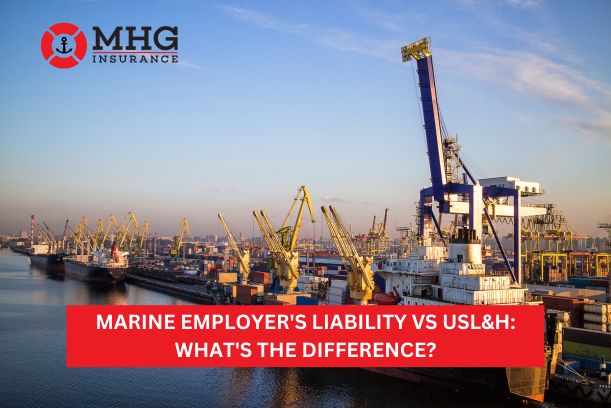
Marine Employer's Liability vs USL&H: What's the Difference?
If you are a marine employer operating globally, understanding your insurance coverage is critical. Unfortunately, there is a lot of confusion around two important policies: Marine Employer's Liability (MEL) and United States Longshore and Harbor Workers' Compensation Act (USL&H) coverage. Many companies assume they are protected by one when they actually need the other, or both. This misunderstanding can leave your business dangerously exposed.
Let's break it down clearly so you can confidently protect your team and your operations.
What Is Marine Employer's Liability (MEL)?
Marine Employer's Liability insurance is designed to protect employers when their crew members suffer injury, illness, or death outside the scope of traditional workers' compensation or Protection and Indemnity (P&I) coverage.
MEL often comes into play when workers are employed on vessels but are not covered under maritime laws like the Jones Act. It typically covers legal defense costs, settlements, and damages for which the employer may be held liable.
According to the International Risk Management Institute (IRMI), MEL is intended for "employers who do not have U.S. citizen seamen covered under the Jones Act" (IRMI, 2024). This is especially important for businesses employing foreign crew, working internationally, or operating on a variety of different vessel types.
What Is USL&H Coverage?
USL&H insurance refers to the United States Longshore and Harbor Workers' Compensation Act. This federally mandated coverage protects land-based maritime workers like longshoremen, harbor workers, shipbuilders, and ship repairers. These employees are not considered seamen and are not eligible for Jones Act protections, but they perform critical duties related to vessels.
The U.S. Department of Labor describes USL&H as providing "medical care, compensation for lost wages, and rehabilitation services" for employees who are injured while working on navigable waters or in adjoining areas like docks and shipyards (U.S. Department of Labor, 2024).
If your employees ever step foot onto a pier, dry dock, or wharf for work, you could be required to carry USL&H coverage, even if you mainly think of them as vessel workers.
Key Differences Between Marine Employer's Liability and USL&H
While both policies protect employers against liabilities related to employee injuries, they apply to very different circumstances:
- Marine Employer's Liability covers crew working on a vessel, typically offshore or at sea.
- USL&H covers land-based maritime workers or employees working near vessels but not considered "crew."
Confusing the two can lead to serious gaps in coverage. For example, an employee injured while prepping a vessel in dry dock could trigger a USL&H claim. If you only have MEL coverage, you might be left with the bill.
According to the American Equity Underwriters, "the absence of USL&H coverage when needed
can result in substantial financial penalties and exposure for employers" (American Equity Underwriters, 2023).
Why the Confusion Happens
Many marine employers think that if they have a general marine insurance policy, it covers everything related to the ocean, the ship, and the employees. However, that is not the case.
Insurance policies are written to be very specific about who is covered, where they are covered, and under what circumstances. MEL and USL&H were created because maritime work environments are so unique and risky that standard workers' compensation policies just do not fit.
A Global Challenge for Marine Employers
This confusion is not limited to U.S. companies. Marine employers around the world face similar challenges. In Europe, for example, maritime laws and insurance standards vary greatly by country. The European Maritime Safety Agency emphasizes that "national regulations differ considerably," making it essential for marine employers to understand not only their local laws but international insurance obligations as well (European Maritime Safety Agency, 2022).
If you are hiring globally, operating vessels internationally, or even just docking in different ports, you must ensure your insurance program meets the right standards everywhere you go.
How MHG Insurance Can Help
For more than 30 years, MHG Insurance has been helping marine employers navigate the complex world of marine insurance. We understand the challenges you face because we live and breathe marine insurance every day. Our team specializes in finding the right coverage that fits your operation, wherever it takes you.
Marine insurance is not just a product. It is a critical piece of your business continuity plan. And when it comes to protecting your employees and your company, there is no room for guesswork.
Do not leave your coverage to chance. Let MHG help you review your current policies, identify any gaps, and build a comprehensive insurance program that gives you peace of mind.
Final Thoughts
The difference between Marine Employer's Liability and USL&H insurance might seem small, but it is crucial. Having the right coverage means protecting your employees, staying compliant with legal requirements, and safeguarding your business from potentially devastating financial losses.
Contact MHG Insurance today for a free consultation and ensure your marine insurance coverage is shipshape: https://mhginsurance.com
Sources (with URLs)
- IRMI (2024). "Marine Employers Liability (MEL) Insurance." https://www.irmi.com
- U.S. Department of Labor (2024). "Longshore and Harbor Workers' Compensation Act." https://www.dol.gov/agencies/owcp/dlhwc/lsfaqs
- American Equity Underwriters (2023). "Understanding the Basics of USL&H Insurance." https://blog.amequity.com/understanding-the-basics-of-uslh-insurance
- European Maritime Safety Agency (2022). "Maritime Legislation in the EU." https://www.emsa.europa.eu/legal-framework.html
Confused about Marine Employer’s Liability vs USL&H? Learn the key differences, risks, and why your marine business might need both to stay fully protected.